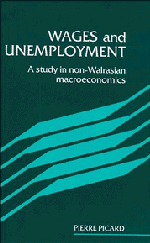Book contents
- Frontmatter
- Contents
- Acknowledgements
- Introduction
- 1 Price rigidities and temporary equilibrium
- 2 Wage rigidity and short-run macroeconomic equilibrium
- 3 Real wages and the inflation—unemployment dilemma
- 4 External constraint, oil shock and economic policy
- 5 Implicit contracts and unions
- 6 Introduction to efficiency wage models
- 7 Efficiency wages, employment fluctuations and fiscal policy
- 8 Labour market dualism, efficiency wages and optimal taxation
- Notes
- References
- Author index
- Subject index
2 - Wage rigidity and short-run macroeconomic equilibrium
Published online by Cambridge University Press: 28 October 2009
- Frontmatter
- Contents
- Acknowledgements
- Introduction
- 1 Price rigidities and temporary equilibrium
- 2 Wage rigidity and short-run macroeconomic equilibrium
- 3 Real wages and the inflation—unemployment dilemma
- 4 External constraint, oil shock and economic policy
- 5 Implicit contracts and unions
- 6 Introduction to efficiency wage models
- 7 Efficiency wages, employment fluctuations and fiscal policy
- 8 Labour market dualism, efficiency wages and optimal taxation
- Notes
- References
- Author index
- Subject index
Summary
The aim of this chapter is to examine how wage rigidities may affect output and employment in the short run. We shall consider a simple macroeconomic model and we shall explore the consequences of various assumptions going from generalized nominal rigidities postulated in the theory of fix-price equilibria to the real wage rigidity emphasized in many non-Walrasian microeconomic analyses of the labour market.
Indeed the theory of fix-price equilibria was the starting point of a macroeconomic analysis concerning the determinants of employment and the efficiency of public policies. These analyses, mainly due to Barro and Grossman (1971, 1976), Bénassy (1976b, 1977a) and Malinvaud (1977), have been carried out within a particularly simple aggregate model, that includes three commodities (a consumption good, labour and money) and usually three agents (a consumer, a firm and the government). Despite its simplicity, the model proves to be particularly relevant to the analysis of macroeconomic consequences of generalized nominal rigidities. Two kinds of unemployment may occur: Keynesian unemployment caused by a low demand for goods, and classical unemployment caused by an inadequate supply. This model provides a theoretical basis to Keynes-inspired stimulating fiscal policies, but it also shows that fiscal measures are inefficient should the unemployment be classical.
- Type
- Chapter
- Information
- Wages and UnemploymentA Study in Non-Walrasian Macroeconomics, pp. 46 - 83Publisher: Cambridge University PressPrint publication year: 1993



